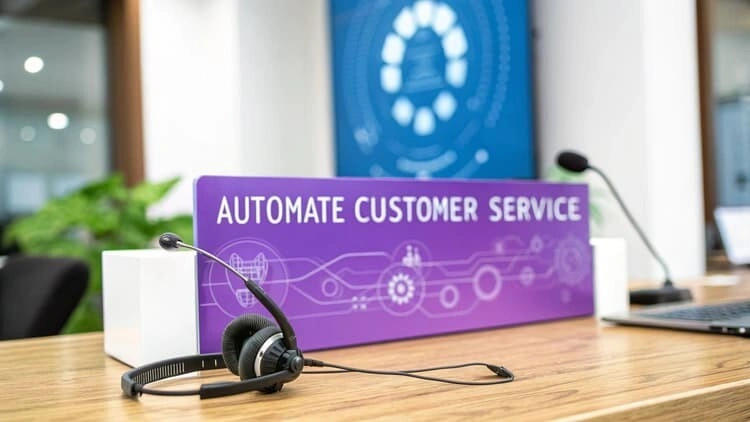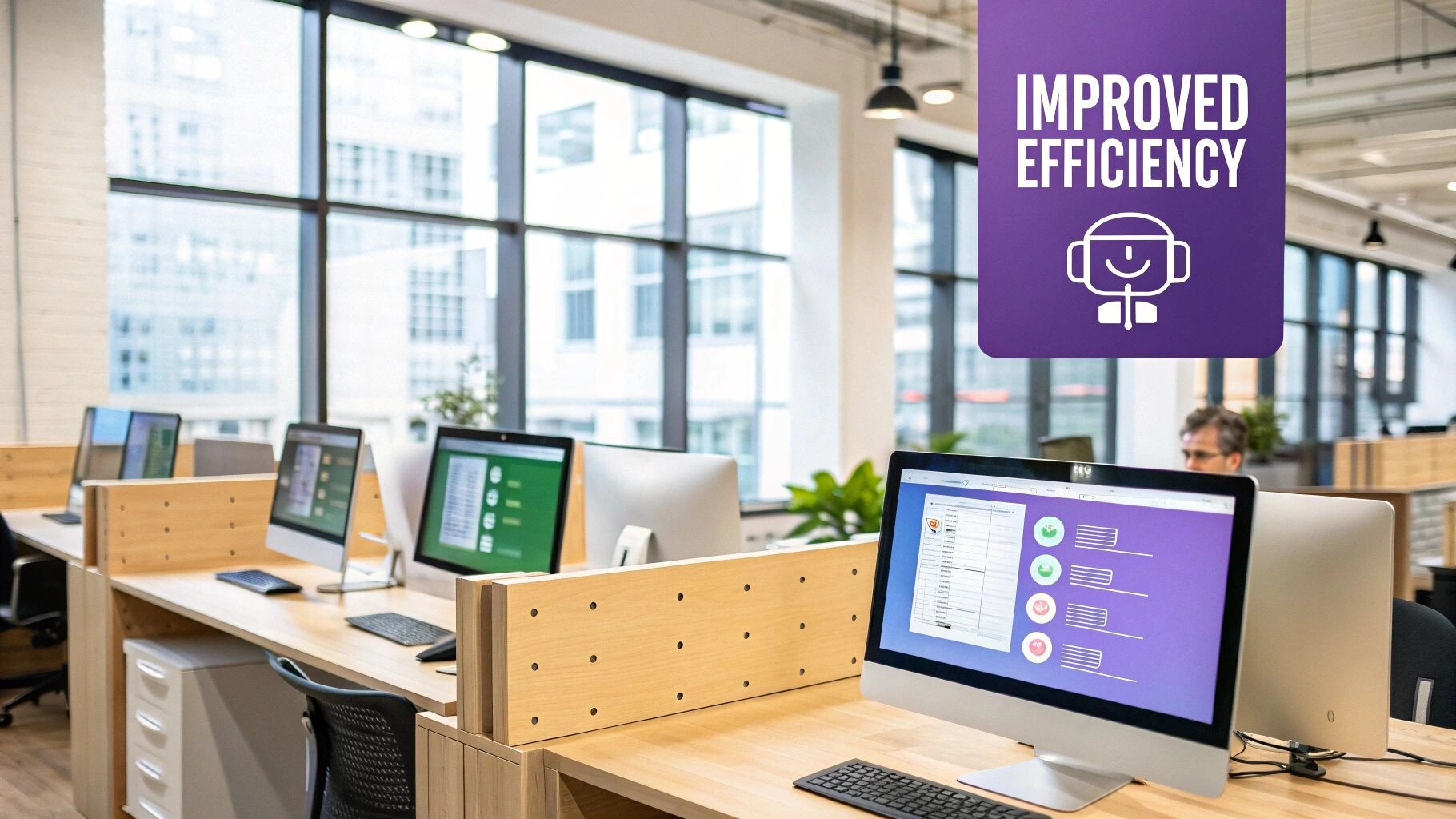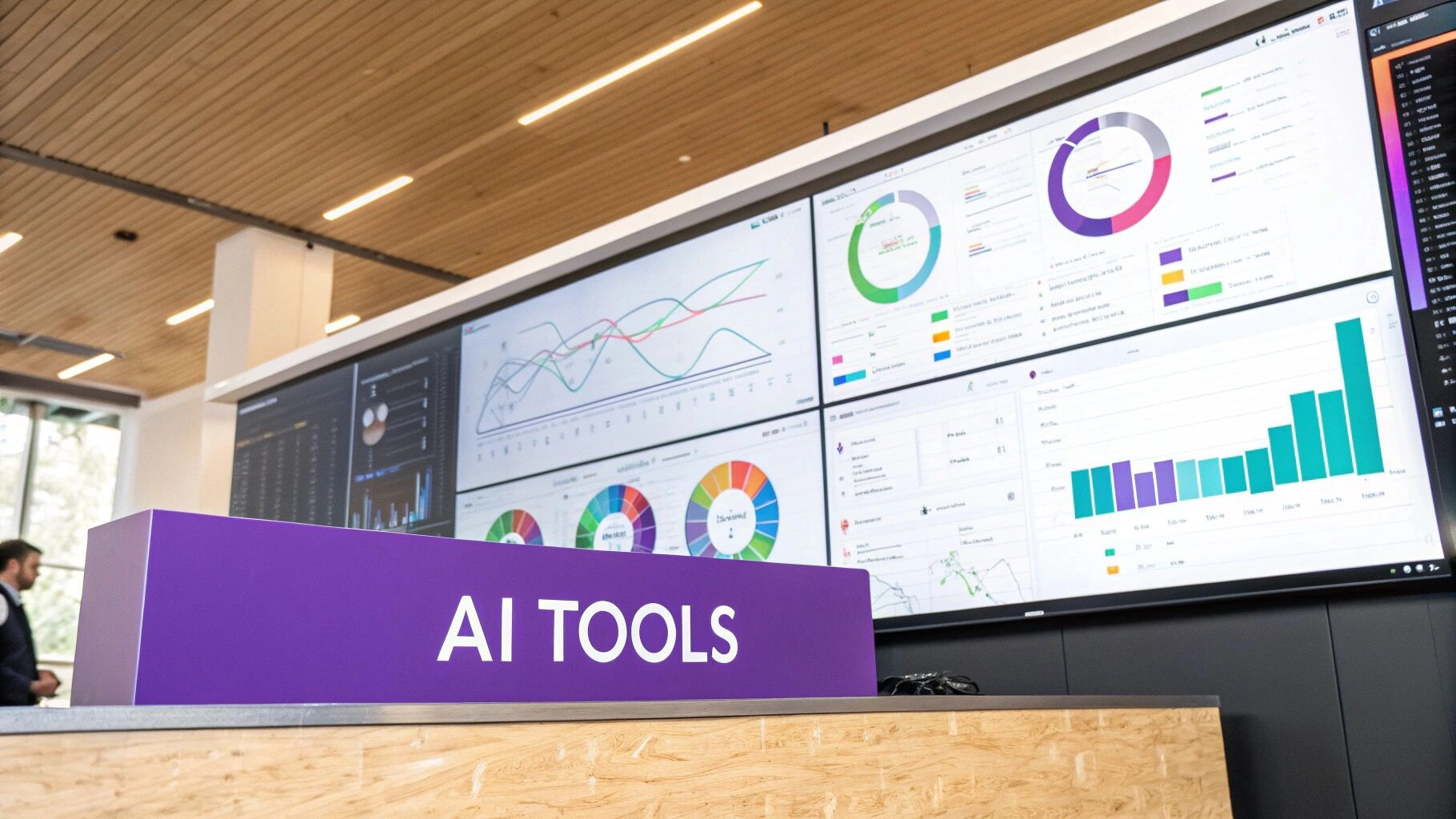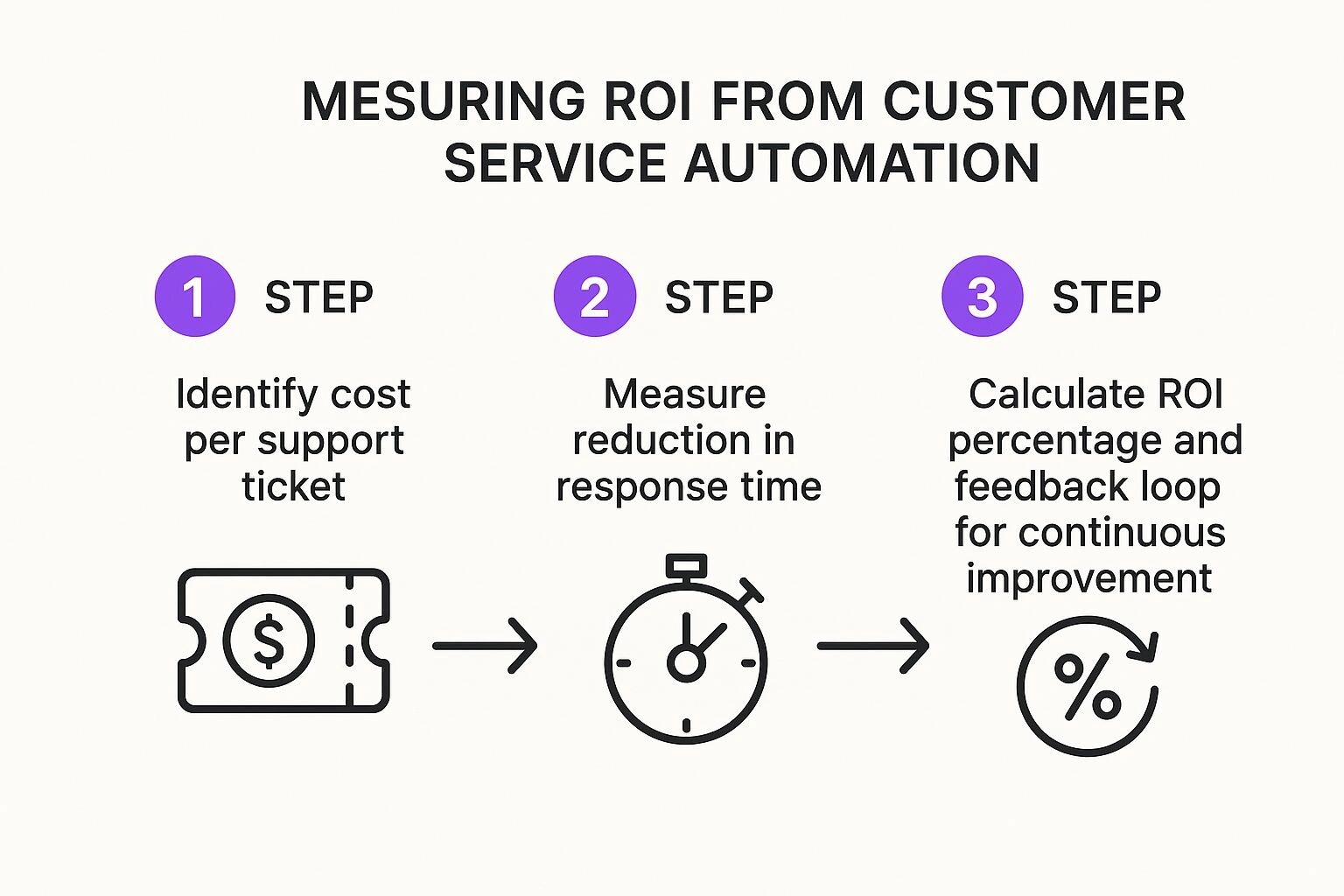Automate Customer Service: Boost Efficiency for Australian Brands
Discover how Australian businesses are using automation to transform customer service—from AI chatbots and predictive analytics to emotional AI and virtual assistants.

The Evolution of Customer Service Automation in Australia
The Australian customer service landscape has changed dramatically.Remember navigating endless phone menus, hoping to finally connect with a real person? This scenario is becoming less common, replaced by a new era of automated support. This shift hasn’t been sudden, but a gradual evolution driven by changing consumer expectations and emerging technologies.
From Cost Savings to Strategic Tool
Initially, many Australian businesses viewed automation primarily as a cost-cutting measure. However, innovative organizations soon recognized that automating customer service offered more than just reduced expenses. It became a strategic tool for improving customer experience and fueling business growth.For more information, check out this article: How to master RPA for SME Customer Service Automation.
This significant change is evident in recent data. As of 2024, over 35% of Australian businesses have incorporated AI or automation technologies into their operations, including customer-facing roles. This aligns with a growing consumer preference for AI-powered interactions, as long as they feel personalized and intuitive. In fact, 57% of Australian consumers prefer AI interactions that exhibit human-like qualities. By 2025, projections suggest AI could manage up to 95% of all customer interactions, including both voice and text-based communication. For additional insights, see these AI and automation adoption statistics.
The Growth of AI-Driven Support
This evolution has been propelled by the rapid advancements in AI.Chatbots, once limited in their capabilities, can now understand complex language and provide nuanced responses. Virtual assistants handle a growing range of tasks, from scheduling appointments to resolving technical problems.Predictive analytics anticipates customer needs, enabling proactive service that addresses potential issues before they arise.
Adapting Consumer Preferences
This movement towards automation fits perfectly with evolving consumer expectations.Australians are increasingly comfortable with self-service choices and value the speed and convenience of automated assistance. They are happy to troubleshoot issues using knowledge bases or get quick answers from chatbots, especially for routine questions.
This does not mean human interaction is obsolete.Instead, automation empowers human agents to concentrate on more complex situations and cultivate stronger customer relationships. The future of customer service involves finding the ideal balance between human interaction and automated efficiency, creating a seamless and personalized experience for every Australian consumer.
Beyond Cost-Cutting: The True ROI of Service Automation

While cost savings are a key driver, the true return on investment (ROI) of automating customer service runs much deeper.Forward-thinking Australian businesses are realizing benefits that extend far beyond simply trimming operational expenses. These advantages contribute to a more positive customer experience and, ultimately, a stronger bottom line.
Faster Response Times and 24/7 Availability
One of the most immediate benefits of automation is significantly faster response times. Automated systems can handle a high volume of inquiries concurrently, providing instant support.This eliminates customer wait times, whether in phone queues or anticipating delayed email replies.
Furthermore, automation allows for 24/7 support, serving customers across various time zones and ensuring assistance is always at hand.This constant availability is a substantial upgrade from traditional service models restricted by business hours.
Consistency and Reduced Errors
Automation also introduces a new level of consistency to customer service. Automated systems deliver the same standard of service every time, eliminating the variability inherent in human interactions. This consistency fosters trust and reinforces reliability with customers.
By minimizing human error in routine tasks, businesses reduce customer frustration and elevate overall satisfaction.
Data-Driven Decisions and Personalisation
Automated systems are invaluable tools for data collection. They capture vital information about customer interactions, preferences, and pain points.This data provides insights that can inform strategic business decisions, guide product development, and personalise the customer experience.
Ultimately, this means a deeper understanding of customer needs and the ability to tailor services accordingly.For a more in-depth look at automation ROI, you might find this helpful: How to master the ROI of Business Process Automation.
Measuring the Holistic Impact
To understand the true ROI of service automation, consider several key metrics. The table below summarizes these key performance indicators and the typical improvements seen after implementing automation.
To better understand the impact of customer service automation, let’s examine some key ROI metrics. The following table compares performance before and after automation.
| Performance Metric | Before Automation | After Automation | Percentage Improvement |
|---|---|---|---|
| Average Response Time | 12 hours | 2 minutes | 99.9% |
| Customer Satisfaction Score | 75% | 92% | 22.6% |
| Resolution Rate on First Contact | 60% | 85% | 41.6% |
| Cost per Contact | $15 | $3 | 80% |
As the table demonstrates, automation can dramatically enhance key customer service metrics, leading to substantial gains in efficiency and customer satisfaction.
By focusing on these broader advantages, Australian businesses can unlock the full potential of service automation and secure a significant competitive edge.The key is to view automation not simply as a cost-cutting measure, but as a strategic tool for enriching the customer experience and propelling business growth.
Automation Technologies That Actually Deliver Results

Let’s move past the theory and delve into the practical tools reshaping Australian customer service.These technologies are transforming how businesses interact with customers, resulting in noticeable improvements to efficiency and customer satisfaction.
AI Chatbots: Understanding The Aussie Context
One of the most impactful tools is the AI chatbot. These are not your simple, rule-based bots of the past.Modern AI chatbots, powered by natural language processing (NLP), understand the nuances of Australian English and handle a wide range of customer inquiries. This allows for quick resolution of issues, providing 24/7 support, and freeing up human agents to handle more complex problems.
Virtual Assistants: Handling Complex Queries
Going a step beyond chatbots, virtual assistants offer a more sophisticated level of support.These AI-powered tools can handle complex queries, offer personalized recommendations, and even proactively address potential issues. They integrate with other business systems, such as CRM and order management platforms, to provide comprehensive customer assistance.
Intelligent Routing: Connecting Customers Efficiently
Intelligent routing instantly directs customer inquiries to the most appropriate agent or resource. These systems analyze the nature of the query and connect customers with the right support channel immediately, eliminating frustrating transfers.This approach significantly boosts efficiency and enhances the customer experience. Many customer service automation initiatives rely on underlying workflow automation.
Predictive Analytics: Anticipating Customer Needs
Predictive analytics is transforming customer service by allowing businesses to anticipate customer needs. By analyzing customer data, these systems identify potential issues and proactively offer solutions. This shifts customer service from reactive problem-solving to proactive customer engagement.
Self-Service Knowledge Bases: Empowering Customers
Empowering customers to find their own solutions is crucial in modern customer service. Self-service knowledge bases provide a library of FAQs, how-to guides, and troubleshooting articles. This allows customers to resolve common issues independently, reducing support ticket volume and allowing agents to focus on more specialized requests.
The Shift In Customer Expectations
The effectiveness of these technologies is underscored by shifting customer expectations. Australian consumers are increasingly comfortable with automated customer service.Zendesk’s 2025 CX Trends Report shows that 39% of consumers trust AI systems with tasks like order tracking, especially if the AI feels human-like.59% of Australians find voice AI easier than text for complex queries.On the business side, 76% of Australian customer experience leaders believe AI adoption is critical and report positive ROI from AI tools.Furthermore, 73% of Australian consumers consider customer service key to brand loyalty.These statistics demonstrate a clear shift towards AI-driven solutions, highlighting the importance of automation for building trust and loyalty.More detailed statistics can be found here.
Implementing these technologies isn’t simply about following trends; it’s about meeting evolving consumer demands and creating a more efficient and satisfying customer service experience.
The Human-Machine Partnership: Finding the Sweet Spot

The true potential of automated customer service isn’t about replacing human agents entirely.Instead, it’s about creating a powerful synergy between humans and machines.This involves strategically combining the efficiency of AI with the empathy and nuanced understanding that only human interaction can provide. The goal?An exceptional and personalized customer experience.Leading Australian brands are already showcasing how to achieve this balance effectively.
Designing Seamless Customer Journeys
Creating a positive customer experience involves designing journeys that seamlessly integrate AI and human touchpoints.Imagine a customer initially interacting with an AI chatbot for a simple request, like checking their order status.If the query becomes more complex or requires emotional support, the interaction can be smoothly transferred to a human agent.This ensures customers receive the appropriate level of support at each stage of their journey.
Identifying Opportunities for Automation and Human Touch
The core of this approach is carefully determining which customer service interactions are best suited for automation and which require a human touch.Routine tasks, such as answering frequently asked questions, providing basic product information, and processing simple transactions, are often perfect candidates for automation.This allows human agents to dedicate their time and expertise to more demanding situations that require empathy, critical thinking, and complex problem-solving skills.
The Evolving Role of Service Professionals
As automation takes over routine tasks, the role of customer service professionals is evolving.Rather than spending time on basic inquiries, agents become strategic problem-solvers, equipped with AI-driven insights and tools.They can then focus on building stronger customer relationships, managing challenging situations, and delivering truly personalized support.This shift empowers agents to excel and provide exceptional service.
The ServiceNow 2025 Customer Experience Report underscores the importance of this approach in Australia.The report reveals that Australian customers interact with brands across up to seven different channels.Furthermore, only 23% of organizations have integrated their customer management systems, forcing agents to navigate multiple systems for each query.This complexity highlights the need for streamlined, AI-powered solutions.While 63% of Australian consumers prefer self-service options and 42% desire 24/7 support – both achievable through automation – 69% of agents believe their organizations take too long to resolve customer issues. This gap between customer expectations and current service capabilities emphasizes the potential of AI’s real-time analysis and intelligent routing to improve speed and efficiency.
Building the Ideal Human-Machine Partnership
Establishing the ideal human-machine partnership requires a strategic and considered approach:
-
Clear Frameworks:Develop clear guidelines that dictate when AI should manage interactions and when human intervention is necessary.This ensures a consistent and effective customer experience.
-
Emotional Intelligence: Equip AI systems with the ability to recognise emotional cues in customer interactions and seamlessly escalate those interactions to human agents when appropriate.
-
Agent Empowerment: Provide agents with the necessary tools and training to thrive in their evolved roles as strategic problem-solvers.This empowers them to handle complex issues and deliver personalized support.
-
Continuous Optimization:Regularly evaluate and refine the human-machine partnership to ensure it adapts to evolving customer needs and maintains a high level of service.
By adopting this collaborative approach, Australian businesses can fully realise the benefits of automation while preserving the essential human element that builds trust and fosters customer loyalty. This balanced strategy will be critical for success in the future of customer service.
Your Roadmap to Automate Customer Service Successfully

The infographic above illustrates how to measure the ROI of your customer service automation. It covers everything from the cost of each support ticket to calculating your overall ROI percentage and establishing a feedback loop for continuous improvement.As the infographic shows, measuring ROI is not a one-time activity, but a continuous process. This feedback loop helps you adapt your automation strategies for maximum impact.
Ready to transform your customer service but unsure where to begin? Implementing effective automation can feel overwhelming.However, with a structured approach, the process becomes manageable and yields significant rewards.This section provides a practical roadmap for your automation journey.
Assessing Your Current Situation and Identifying Pain Points
The first step is an honest assessment of your current customer service operations. What are your team’s biggest challenges?Where are the bottlenecks that slow down response times and lead to customer frustration?Are there repetitive tasks that consume valuable agent time, tasks that could be automated?Identifying these pain points is essential to focusing your automation efforts where they’ll make the biggest difference.
Selecting the Right Technology For Your Needs
After pinpointing areas for improvement, the next step is selecting the right automation tools.There are many options available, from AI-powered chatbots to virtual assistants capable of handling complex inquiries. Other valuable tools include intelligent routing systems, predictive analytics, and self-service knowledge bases.Choose technologies that align with your specific business goals and integrate seamlessly with your existing systems. For instance, if you process a high volume of invoices, you might find this resource helpful: How to master automated invoice processing with computer vision.
Implementing and Managing Change Effectively
Implementing new technology is just the first step. Managing the change effectively is equally crucial. This involves preparing your team and your customers for the new automated processes.Provide thorough training for your team, ensuring they’re comfortable using the new tools and understand their evolving roles.Communicate clearly with your customers about the changes, highlighting the benefits of automation, such as faster response times and 24/7 availability.
Establishing Clear Metrics for Success
To accurately measure the impact of your automation efforts, establish clear metrics from the start.Track key performance indicators (KPIs) such as average response time, first-call resolution rate, customer satisfaction scores, and cost per contact.Regularly monitor these metrics to assess the effectiveness of your strategy and pinpoint areas for continuous improvement.
Realistic Timelines and Common Pitfalls
Implementing customer service automation is an ongoing process. It’s essential to set realistic timelines and understand that it might take time to realise the full benefits. Be prepared to adapt your strategy and address any challenges that arise. For example, ensure your AI systems are trained to understand the nuances of your target audience’s language and specific needs.Maintain a balance between automation and human interaction, reserving human intervention for situations requiring empathy and complex problem-solving.
To help illustrate a practical implementation approach, let’s look at a phased rollout plan:
Customer Service Automation Implementation Timeline
This table outlines a phased approach to implementing customer service automation with key milestones and activities.
| Phase | Timeline | Key Activities | Success Indicators |
|---|---|---|---|
| Phase 1: Assessment and Planning | 1-2 Months | Analyze existing customer service processes. Identify key pain points and areas for automation. * Define project scope and objectives. |
Documented current state analysis. Prioritized list of automation opportunities. |
| Phase 2: Technology Selection and Implementation | 2-3 Months | Evaluate and select appropriate automation tools. Integrate chosen tools with existing systems. * Develop and configure automation workflows. |
Successful integration of chosen technologies. Functional automation workflows. |
| Phase 3: Training and Rollout | 1-2 Months | Train customer service team on new tools and processes. Conduct pilot testing and gather feedback. * Gradually roll out automation to wider customer base. |
Increased team proficiency with new tools. Positive feedback from pilot test group. |
| Phase 4: Monitoring and Optimization | Ongoing | Monitor key metrics and track performance. Identify areas for improvement and refine automation strategies. * Continuously adapt to changing customer needs and business goals. |
* Consistent improvement in key metrics (e.g., response time, customer satisfaction). |
This phased approach ensures a structured and manageable implementation, maximizing the chances of success while minimizing disruption. By focusing on careful planning, thoughtful technology choices, thorough training, and continuous monitoring, businesses can leverage the full potential of customer service automation.
The Future of Automated Service: What’s Next for Australia
The customer service automation journey is a continuous process of refinement and improvement. For Australian businesses keen to maintain a competitive edge, staying ahead of the curve is paramount.Exciting new developments are poised to reshape the customer service landscape, focusing on delivering more personalized, efficient, and proactive support.
Emotional AI: Understanding Customer Sentiment
A significant advancement is the emergence of emotional AI.This technology moves beyond simply interpreting words. It analyzes vocal nuances, pauses, and other subtle cues to gauge customer sentiment. This means automated systems can identify frustration, confusion, or satisfaction, tailoring responses appropriately.
For instance, if a customer expresses anger, the system could automatically escalate the interaction to a human agent trained in handling sensitive situations.This facilitates more empathetic and effective support, even in challenging scenarios.
Augmented Reality: Transforming Remote Support
Augmented reality (AR) is another transformative technology. Imagine a customer struggling to assemble a product. With AR, a remote support agent can virtually “see” the customer’s view through their smartphone camera.
The agent can then offer real-time, visual guidance, overlaying instructions and diagrams directly onto the customer’s perspective.This significantly enhances the effectiveness of remote support, simplifying technical problem resolution and delivering personalized assistance.
Proactive Service: Anticipating Customer Needs
The future of customer service lies in anticipating customer needs before they arise. Proactive service leverages AI to identify potential issues and offer solutions before customers are even aware of a problem.
This could involve sending personalized reminders, offering proactive troubleshooting advice, or even automatically resolving issues behind the scenes. For guidance on implementing automated customer support, resources like this article on how to automate customer support can be valuable. This shift from reactive to proactive support elevates the customer experience and builds loyalty.
Preparing for the Future of Automated Service
These emerging technologies present valuable opportunities for Australian businesses.To prepare for the future of automated service, consider these key steps:
- Invest in Infrastructure:Ensure your systems are equipped to handle the demands of these advanced technologies. This may involve upgrading your CRM system, implementing a unified communication platform, or investing in cloud-based solutions.
- Develop Team Skills:Provide your team with the necessary skills to thrive in this changing landscape.This could include training in emotional intelligence, AR support techniques, or data analysis.
- Embrace a Customer-Centric Approach: Focus all automation efforts on improving the customer experience.This includes gathering customer feedback, continuously optimizing your systems, and maintaining a balance between automation and human interaction.
By adopting these advancements and preparing strategically, Australian businesses can harness the full potential of automated service and secure a competitive advantage in the coming years.
Ready to transform your customer service and enhance efficiency? Partner with Osher Digital to implement tailored automation solutions.Visit their website to learn more about automating your customer service and achieving your business goals.
Jump to a section
Ready to streamline your operations?
Get in touch for a free consultation to see how we can streamline your operations and increase your productivity.